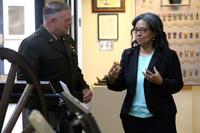When Europeans first came to North America, American bison roamed large swathes of land, stretching from the Great Plains to Mexico. Native tribes depended on these herds for food, clothing and tools, a sacred relationship, one that nearly led to the extinction of the species when it became a prime target for the U.S. Army during the Plains Wars.
In its effort to subdue the tribes of American Indians who would not be resettled onto reservations, the U.S. launched a campaign against the herds. If they could destroy the tribes' essential sources of food and materials, they could destroy the tribes. By the end of the 19th century, the bison's number plummeted from 30 million to just a few hundred.
Farming and ranching of herds has allowed the bison to return from the brink of extinction, coupled with extensive federal protections of the animals. There is one herd, however, that has the best protection available: the United States Marine Corps.
Marine Corps Base Camp Pendleton is home to one of just two protected herds of American bison in California, with the other herd managed on Catalina Island. The Marine Corps herd can be found roaming in Delta and Charlie training areas, the Zulu Impact Area and in Case Springs, areas off-limits to the general public.
Camp Pendleton first received its bison from the San Diego Zoo between 1973 and 1979. The earliest numbers were small, just 14 individuals. The installation was a perfect home for the bison, and not just because there's no better friend than the Marines. Camp Pendleton is enormous; with 125,000 acres of land and two natural water sources, there's plenty of room on the range to roam.
Over time and with protection from the Marine Corps, the number of bison has grown so much, they sometimes interfere with basic training and base operations. By 1987, the Marine Corps estimated the herd had grown to 50. In 1999, the number was 62. Today, it estimates there are 90 on the base.
The herd is managed by the Camp Pendleton Game Warden's Office, which advises viewers to stay at least 150 feet away from the six-foot-tall, 2,000-pound gentle giants. While not as aggressive as predatory animals, bison are still defensive and can turn aggressive very quickly.
When threatened or repeatedly approached, bison will use that bulk to ward off potential attackers. Most injuries at the hands (hooves) of bison usually come because an onlooker got too close to the animal. It's hard to blame a species that was almost hunted to extinction for being overly cautious.

Camp Pendleton says its game warden's office is responsible for monitoring the bison population and keeping track of its genetic diversity, overall health and total population. The bisons' genetic diversity is an ongoing tragedy of the animal's history, as only a small percentage are genetically pure bison in the U.S. and Canada. Camp Pendleton's bison have been cross-bred with domestic cattle.
The Game Warden's Office has a management plan that allows the bison to roam free while keeping them (as best they can) from interfering with Marine Corps training exercises. Still, accidents happen.
The Marine Corps estimates two bison from the herd die each year, either from car accidents or some other kind of mishap. That kind of success will likely ensure the Marine Corps bison are welcome on Camp Pendleton for the foreseeable future.
-- Blake Stilwell can be reached at blake.stilwell@military.com. He can also be found on Twitter @blakestilwell or on Facebook.
Want to Learn More About Military Life?
Whether you're thinking of joining the military, looking for post-military careers or keeping up with military life and benefits, Military.com has you covered. Subscribe to Military.com to have military news, updates and resources delivered directly to your inbox.













